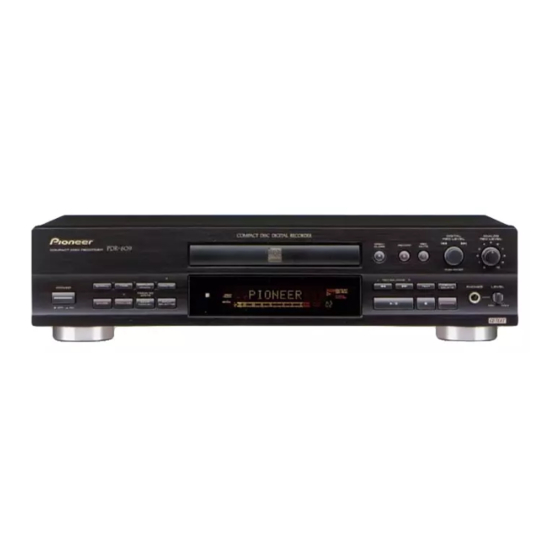Pioneer PDR-609 Kullanım Talimatları Kılavuzu - Sayfa 6
CD Çalar Pioneer PDR-609 için çevrimiçi göz atın veya pdf Kullanım Talimatları Kılavuzu indirin. Pioneer PDR-609 44 sayfaları. Compact disc recorder
Ayrıca Pioneer PDR-609 için: Kullanım Talimatları Kılavuzu (44 sayfalar)

1 Before you start
Features of the PDR-609 CD recorder
Create your own audio CDs
At last, there's a convenient and affordable way to make your own audio CDs. Create your own original recordings, or put together
compilations of your favorite tracks from your existing CDs. Other uses include making high-quality recordings from radio or
satellite broadcasts, and making personal copies of CDs, MDs, etc. to keep in the car, keeping the originals safe at home. The CD text
feature of the PDR-609 allows you put text information on your recordings to easily identify and select from the contents.
Make digital recordings from any source
The PDR-609 can accept digital input via optical or coaxial cable, meaning that you can connect it to almost any other digital audio
component. Also, thanks to the built in sampling rate converter, you can make direct digital recordings from satellite (usually
32kHz), DCC and DAT (up to 48kHz), as well as CD and MD (both 44.1kHz). A sampling rate converter 'through' feature (for 44.1kHz
sources only) enables you to record HDCD and DTS encoded CDs too. Analog sources are also catered for with the analog line inputs,
suitable for connection to standard audio components such as cassette decks and turntables.
Use both ordinary recordable CDs and rewritable CDs
Ordinary recordable CDs (CD-R) can be recorded on just once, but the relatively cheap cost of blank discs and the ability to play the
recorded discs on any ordinary CD player* make them ideal for many applications. Compact Disc Rewritable, or CD-RW, is a more
recent type of recordable CD that allows erasing and re-recording of the disc. Although the blank discs are more expensive, this ability
to use the discs over and over gives them the edge in terms of flexibility over CD-R**.
* While most CD players should have no problems with
CD-R discs, if the laser pickup is dirty (from prolonged exposure to tobacco smoke, for example), the player may not be able to
read some CD-R discs.
** At the time of writing, most ordinary CD players cannot play CD-RW discs. Check in the instructions that came with the player for
compatibility.
Checking what's in the box
Make sure that you've received the following supplied
accessories with your PDR–609 CD Recorder:
1 Two sets of audio cords
2 AC power cord
• Also included in the box is your warranty card and this
instruction manual.
Using this manual
This manual is for the PDR–609 CD Recorder. It is split into
two sections: the first shows how to set up the CD recorder; the
second takes you through each stage of operation. Set up,
which starts here, shows you how to get your new CD recorder
up and running with the rest of your stereo system.
In the second section of the manual, starting on page16,
you'll learn how to use the various features of the recorder.
The final part of the manual provides reference information
on display messages you might encounter during use, a
troubleshooting section, and technical specifications.
Downloaded From Disc-Player.com Pioneer Manuals
6
3 Two 'AA' size R6P batteries
4 Remote control unit
Hints on installation
We want you to enjoy using the PDR–609 for years to come,
so please bear in mind the following points when choosing a
suitable location for it:
Do...
Use in a well-ventilated room.
Place on a solid, flat, level surface, such as a table, shelf or
stereo rack.
Don't...
Use in a place exposed to high temperatures or humidity,
including near radiators and other heat-generating
appliances.
Place on a window sill or other place where the player will
be exposed to direct sunlight.
Use in an excessively dusty or damp environment.
Place directly on top of an amplifier, or other component
in your stereo system that becomes hot in use.
Use near a television or monitor as you may experience
interference—especially if the television uses an indoor
antenna.
Use in a kitchen or other room where the player may be
exposed to smoke or steam.
Place on an unstable surface, or one that is not large
enough to support all four of the unit's feet.
